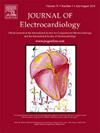心电图左、右轴偏差作为长期死亡率的预测指标
IF 1.2
4区 医学
Q3 CARDIAC & CARDIOVASCULAR SYSTEMS
引用次数: 0
摘要
以前的研究已经将心电图QRS轴偏差与死亡率增加联系起来,但它们主要集中在狭义人群上,很少检查长期死亡率。目的在控制人口统计学和心电图变量的情况下,评价左轴偏差(LAD)和右轴偏差(RAD)与10年全因死亡率的相关性。方法对随机选择的1287例在单一学术医疗中心进行的心电图进行回顾性队列研究。心电图分为正常轴、LAD或RAD,随访时间长达10年。Cox比例风险回归用于估计死亡风险,调整了人口统计学和心电图协变量。结果绝大多数心电图轴向正常者(90.3%),LAD为6.7%,RAD为3.0%。LAD和RAD的10年死亡率(65.1%)明显高于轴向正常者(28.4%)(log-rank p <;0.001)。单因素分析中,LAD(风险比[HR] = 3.04, 95% CI: 2.29-4.04, p <;0.001)和RAD (HR = 2.16, 95% CI: 1.36-3.43, p = 0.001)与死亡风险显著增加相关。在校正分析中,LAD (HR = 1.58, 95% CI: 1.15-2.18, p = 0.005)和RAD (HR = 2.17, 95% CI: 1.32-3.58, p = 0.002)仍然与死亡率增加相关。结论qrs轴偏差是10年全因死亡率的重要预测指标,可作为长期死亡率风险分层的有效工具。本文章由计算机程序翻译,如有差异,请以英文原文为准。
Left and right axis deviation on ECG as predictors of long-term mortality
Background
Previous studies have linked electrocardiographic QRS axis deviation to increased mortality, but they have primarily focused on narrowly defined populations and rarely examined long-term mortality.
Objective
To evaluate the extent to which left axis deviation (LAD) and right axis deviation (RAD) are associated with 10-year all-cause mortality while controlling for demographic and electrocardiographic variables.
Methods
We conducted a retrospective cohort study of 1287 randomly selected ECGs performed at a single academic medical center. ECGs were categorized as normal axis, LAD, or RAD. Patients were followed for up to 10 years. Cox proportional hazards regression was used to estimate mortality risk, adjusting for demographic and electrocardiographic covariates.
Results
Most ECGs showed a normal axis (90.3 %), while 6.7 % had LAD and 3.0 % had RAD. Ten-year mortality was significantly higher in patients with LAD (65.1 %) and RAD (48.7 %) compared to those with a normal axis (28.4 %) (log-rank p < 0.001). In univariate analysis, LAD (hazard ratio [HR] = 3.04, 95 % CI: 2.29–4.04, p < 0.001) and RAD (HR = 2.16, 95 % CI: 1.36–3.43, p = 0.001) were associated with significantly increased mortality risk. In adjusted analyses, both LAD (HR = 1.58, 95 % CI: 1.15–2.18, p = 0.005) and RAD (HR = 2.17, 95 % CI: 1.32–3.58, p = 0.002) remained associated with increased mortality.
Conclusion
QRS axis deviation is a significant predictor of 10-year all-cause mortality and may serve as a useful tool for long-term mortality risk stratification.
求助全文
通过发布文献求助,成功后即可免费获取论文全文。
去求助
来源期刊

Journal of electrocardiology
医学-心血管系统
CiteScore
2.70
自引率
7.70%
发文量
152
审稿时长
38 days
期刊介绍:
The Journal of Electrocardiology is devoted exclusively to clinical and experimental studies of the electrical activities of the heart. It seeks to contribute significantly to the accuracy of diagnosis and prognosis and the effective treatment, prevention, or delay of heart disease. Editorial contents include electrocardiography, vectorcardiography, arrhythmias, membrane action potential, cardiac pacing, monitoring defibrillation, instrumentation, drug effects, and computer applications.
 求助内容:
求助内容: 应助结果提醒方式:
应助结果提醒方式:


